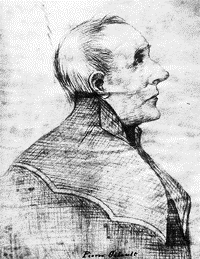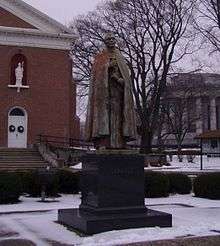Pierre Gibault
Father Pierre Gibault (7 April 1737 – 16 August 1802) was a Jesuit missionary and priest in the Northwest Territory in the 18th century, and an American Patriot during the American Revolution.

Frontier Missionary
Gibault was born 7 April 1737 at Montreal, the son of Pierre Gibault and Marie Saint-Jean, and was baptised the same day.[1] He was educated as a missionary and ordained as priest at Quebec on 19 March 1768,[2] and was quickly appointed Vicar General of the Archbishop of Quebec for the Illinois country.[3]
When France lost the Northwest Territory to Great Britain in 1763, Jesuit priests were expelled. Catholic communities had to rely on local laity to lead their congregations. In July he arrived at Michilimackinac, where he spent a week attending to the religious needs of the Catholics, some of whom had not seen a priest for many years. Fr. Gibault arrived in Kaskaskia on 8 September 1768, where he served Catholics of French and Indian ethnicity, as well as members of the 18th Royal Irish Regiment who were stationed there.[4] He first arrived in Vincennes in 1769, where a crowd greeted him with cries of "Save us, Father; we are nearly in Hell!" [5]
Father Gibault oversaw a circuit of parishes, including Vincennes, Kaskaskia, Ste Genevieve, and Cahokia. He also visited settlements as far as Ouiatenon, Peoria, and St. Joseph. The territory was still considered dangerous frontier, and Gibault carried a gun and two pistols.[6]
In 1770 he blessed the little wooden chapel that had been erected at Paincourt, the present site of St. Louis. Gibault officiated at the chapel regularly in spite of being under the authority of the bishop of Quebec and being a British subject, and he performed dozens of masses and sixty-four baptisms until 1772, when a Capuchin priest named Valentine became the first resident priest.[7]
The Patriot Priest
Father Gibault was in Kaskaskia in 1778 when George Rogers Clark arrived. According to Clark, Fr. Gibault stated that he supported the Americans, but was concerned for his Catholic congregation. Clark assured him that by the laws of Virginia, they would be free to worship as they wished.[8] Clark also informed Gibault of the newly signed treaty between the United States and France.
Gibault convinced the Canadian residents under his care to support the Americans. He further convinced the residents to recognize American continental paper money. Gibault often exchanged Spanish milled dollars for an equal amount of continental promissary notes, and by 1783 estimated that this cost him 7,800 livres.[9] Father Gibault, together with Spanish trader Francis Vigo, is considered to have funded most of the Illinois campaign.

Clark told Fr. Gibault of his plans to take Vincennes, but Gibault stated that he could do this without troops. Fr. Gibault and Dr. Jean-Baptiste Laffont (surname variations include LaFond, LaFont)[10][11] left Kaskaskia on 14 July 1778 and converted an overwhelming majority of Vincennes residents to the American cause. The population raised a new American flag at the abandoned Fort Sackville, wrapping the British flag around a stone and discarding it into the Wabash River.[12] Gibault returned to Kaskaskia and reported the news to Clark.
When Lt-Governor Henry Hamilton retook Fort Sackville and Captain Leonard Helm, Gibault found himself confined to Vincennes. Hamilton then captured Francis Vigo, a Spanish citizen and therefore a non-combatant. Father Gibault conducted Sunday mass, then led his entire congregation to Fort Sackville, where he informed Hamilton that all supplies would be denied to the garrison until Vigo was released.[13] Vigo was released, and informed Clark of the capture of Vincennes. Gibault soon returned to Kaskaskia, and blessed a force of Canadians and Virginians led by Clark to re-capture Vincennes in February 1779.[14]
For his services to the Americans, Gibault was viewed disfavorably by his fellow clergy, who had remained loyal to the British government. Father Gibault actually requested a move to Quebec in 1788, but was denied by the Bishop due to a disadvantageous opinion that the government had formed of him.[15]
In a letter from Cahokia dated 1 May 1790, Father Gibault detailed his services and the debts owed him to Arthur St. Clair. He asked, as a "concession," that the United States would legally grant some land in Kaskaskia- which had traditionally been used by priests- to him and his successors. The request was forwarded on and granted by President George Washington, but the newly appointed American Bishop objected.
Without land or compensation, Father Gibault moved to New Madrid, Missouri, pastoring the parish of Saint-Isidore until his death on 16 August 1802. His body was sent to Canada, but his grave is unmarked.[16]
Namesakes
- USS Pierre Gibault is named for Father Gibault.
- Gibault Catholic High School in Waterloo, Illinois is named for Father Gibault.
- Gibault, Inc., dba Gibault Children's Services, based in Terre Haute, Indiana is also named for Father Pierre Gibault and was founded in 1921 by the Indiana Knights of Columbus.
- Good Samaritan Hospital in Vincennes, Indiana is constructing a new building to be named Gibault Memorial Towers. The expected completion date is mid-2016
Notes

- NPS
- Cauthorn, 172
- O'Brien John J. (1909). . In Herbermann, Charles (ed.). Catholic Encyclopedia. 6. New York: Robert Appleton Company.
- English, pg 186
- History of the Old Cathedral, by Basilica of St. Francis Xavier
- English, pg 188
- Primm, James Neal (1998). Lion of the Valley: St. Louis, Missouri, 1764-1980. Missouri History Museum Press. ISBN 978-1-883982-25-6.p. 32
- Law
- Law, 56
- Duay, Debbie. "Index to French Canadian Revolutionary War Patriots". learnwebskills.com. Retrieved 6 August 2015.
- LaFont, Jean Baptiste. "Burial". Find A Grave. Retrieved 6 August 2015.
- Hamilton's Journal, 14 October 1778
- Law, 55
- English, V1, p287
- Donnelly, Joseph P. (1983). "Gibault, Pierre". In Halpenny, Francess G (ed.). Dictionary of Canadian Biography. V (1801–1820) (online ed.). University of Toronto Press.
- Cauthorn, 175
- English, 1:199
![]()
References
- Cauthorn, Henry S. A History of the City of Vincennes, Indiana from 1702 to 1901 1902. Moore & Langen Pringtin Co, Terre Haute, IN.
- Commager, Henry Steele and Richard B. Morris. The Spirit of Seventy-Six. The story of the American Revolution as told by its participants. Castle Books. HarperCollins Publishers. ©1958. LCCN 67-11325. ISBN 0-7858-1463-9.
- English, William Hayden. Conquest of the Country Northwest of the River Ohio 1778-1783 and Life of Gen. George Rogers Clark Vol I. ©1896. The Bowen-Merrill Company. Indianapolis, Ind., and Kansas City, Mo.
- Law, Judge. The Colonial History of Vincennes Harvy, Mason & Co. 1858. ISBN 1-55613-199-2
- Hamilton, Henry Online journal entries.
External links
- National Park Service
- "Father Gibault: The Patriot Priest of the Northwest", address by J. P. Dunn, 1905
- George Rogers Clark's memoir